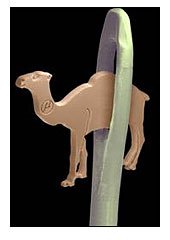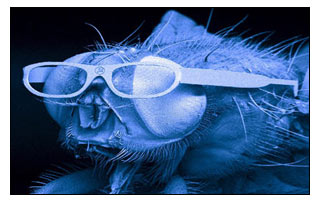HANOVER, Germany, April 14, 2006 -- A German company that uses femtosecond lasers to make ultraprecise components demonstrated its technique last year by creating a pair of eyeglasses for a housefly. Micreon GmbH recently unveiled its latest creation to promote the technology: a tiny camel that can fit through the eye of a needle. The company will display the promotional item at the Hanover Fair, an industrial automation trade show taking place April 24-28 in Hanover.

A camel made by Micreon using ultrashort-pulse lasers passes through the 2 mm high, 0.3 mm wide eye of a needle. The diameter of the logo on the camel's neck is smaller than the thickness of a human hair.
Micreon, a spin-off company of LZH (Laser Zentrum Hannover eV), is the first to use ultrashort-pulse lasers to manufacture highly precise components, said Günter Kamlage, who founded Micreon with former LZH coworker Frank Korte. The lasers can process any material without damaging it, he said, with precisions of less than one thousandth of a millimeter.
"For microfabrication you need a really stable assembly. We use a granite table or an optical table. We take a commercially available ultrashort pulse laser and a positioning machine, do some modification and combine it all. After focusing the laser beam and moving the sample in the programmed direction, we get microdevices" he said. "As a demonstration for the functionality of the technique, we prepared a photo of a camel going through the eye of a needle."
Micreon works with LZH and is a service provider for customers in the medical and technical fields, Kamlage said. LZH was founded under the patronage of the German State Ministry of Trade, Industry, Technology and Transportation in Lower Saxony. The non-profit association’s main task is to support applied research in laser technology.

Micreon made these "flyglasses" last year to promote its ability to manufacture highly precise components.
To promote its technology, last year Micreon developed tiny eyeglasses for a housefly, photographs of which it entered in Germany's Photos of Science 2005 competition, still on exhibit in Munich. The glasses fit snuggly on the fly's 2 mm wide head. This year it created a tiny camel that can pass through a 2 mmhigh, 0.3 mm wide eye of a needle. "We could make it much smaller with the femtosecond laser," Kamlage said. "However, as a demonstrator this is small enough--people will be able to see it without any technical help at the Hanover Fair." Micreon will also display photos of the "flyglasses" at the fair.
"It may well go unnoticed by the layman, but the funny example of a housefly wearing designer glasses demonstrates the large potential of microsystem technology for high-tech products," Kamlage said. "We'd like to convince more engineers with our new technology. Our structure size is below one micrometer. This is one order better other techniques can do. There is a big potential for new microdevices -- a lot of ideas could be realized," Kamlage said.
For more information, visit: www.micreon.de